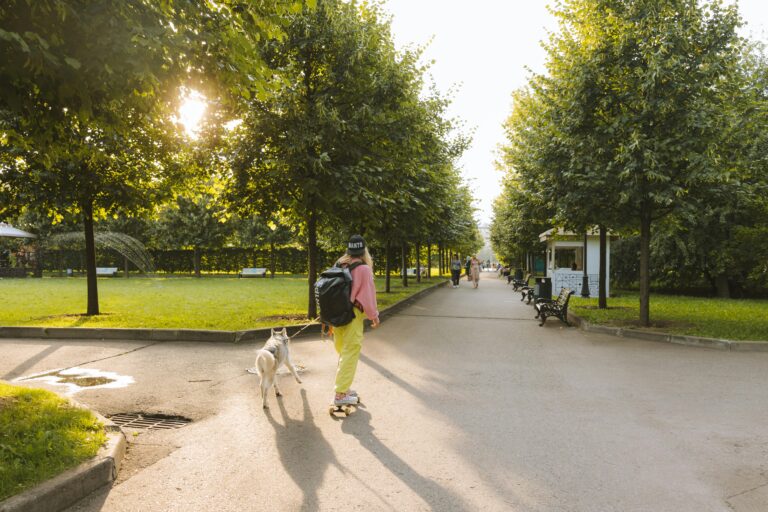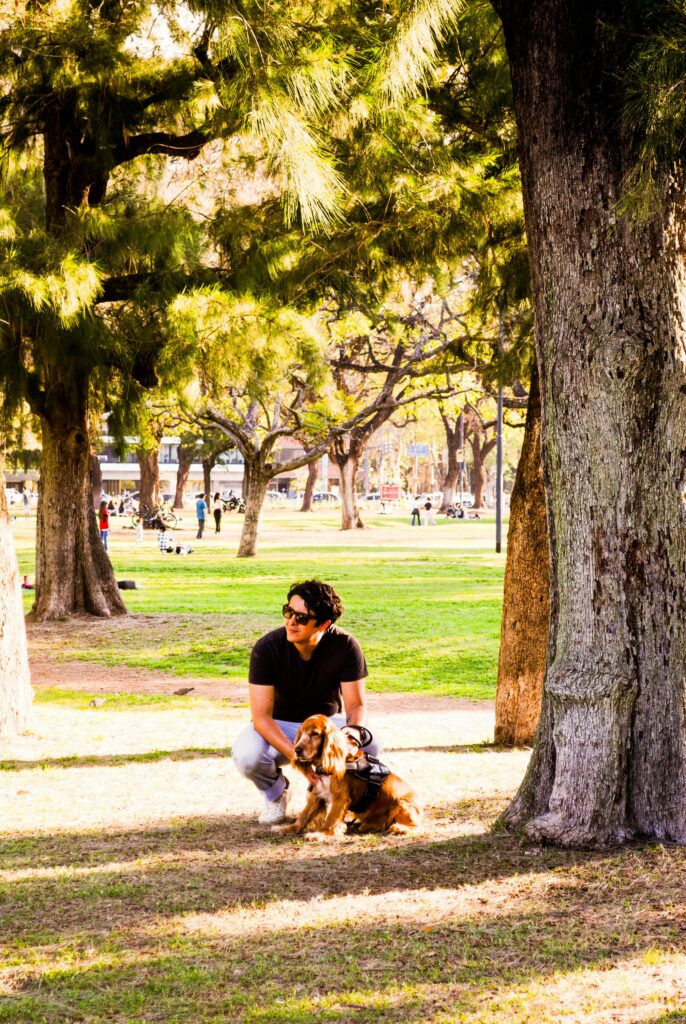Dog socialization is not just about meeting other dogs. It is about preparing your dog to confidently and calmly handle the world around them. Parks, cafes, patios, walking trails, neighborhood events, and even vet visits all introduce new sounds, smells, people, and distractions that your dog must learn to navigate.
As a professional trainer, I work with many St. Louis-area dog owners who struggle with real-world behavior. Their dogs are great at home but fall apart the moment they step into public spaces. If that sounds familiar, the good news is that real-world socialization is a skill you can build just like any other.
Let’s walk through how to structure your dog’s socialization outside the house, what to expect, and how to reinforce the right behaviors from the start.
What Socialization Really Means
Socialization is often misunderstood. It is not just letting your dog meet other dogs or people. Real socialization means teaching your dog how to behave and stay engaged with you in the presence of various environments, stimuli, and surprises.
Effective socialization helps prevent:
- Leash pulling
- Barking or lunging
- Fear of crowds or loud noises
- Resource guarding
- Anxiety in unfamiliar places
Dogs that are well-socialized tend to be more adaptable, more obedient, and less stressed when routines change or when life throws you a curveball.
The Ideal Timeline for Socialization
The earlier you start, the better. Puppyhood is the prime time for imprinting positive associations, but socialization is just as important for adult dogs. Regardless of age, the process should always be gradual and structured.
Start with:
- Short exposure trips to low-traffic environments
- A familiar handler and consistent leash rules
- One outing at a time (not a packed day of errands)
- High-value rewards to reinforce engagement
If your dog struggles with reactivity or overstimulation, our Basic Obedience Program provides a structured foundation to build reliable behavior before advancing to public spaces.
Best Places to Practice Real-World Socialization
Not every public space is equal. Here are a few of the best types of environments for socialization training, along with tips for success.
Outdoor Cafes and Patios
These settings are full of distractions: food smells, people walking by, waitstaff, and other dogs. Start with a quiet patio during off-hours.
Tips:
- Use the “Place” command on a towel or mat
- Reinforce calm behavior with treats or praise
- Avoid allowing strangers to pet your dog without permission
Public Parks and Trails
Great for leash manners, handling other dogs at a distance, and reinforcing focus around squirrels, bikes, or joggers.
Tips:
- Keep your dog in heel position when passing others
- Practice sit-stays and recall between distractions
- Reward eye contact and calm walking
Pet-Friendly Stores
Hardware stores and pet supply shops often allow dogs. These are excellent for practicing walking through aisles, ignoring food, and handling noise.
Tips:
- Avoid peak hours for the first visit
- Work on leash pressure and impulse control
- Use rewards to refocus after distractions
For more ways to reinforce real-world focus, check out our post on how to keep your dog focused during summer group events. Many of the same principles apply to public outings.
Common Socialization Mistakes
Dog owners often unintentionally set their dog up for failure during public socialization. Avoid these common mistakes:
- Rushing into busy spaces too early
- Letting the dog pull toward every person or dog
- Using only verbal corrections instead of guiding with leash and body cues
- Expecting perfect behavior without consistent reinforcement
- Allowing your dog to practice nervous or aggressive behavior unchecked
Remember, every outing is a training session. You are shaping habits, not just passing time.
Use Obedience as Your Social Anchor
When your dog is unsure or distracted, obedience gives them a job to focus on. Practice commands like:
- Place (on a towel or mat at a patio)
- Down-Stay (while waiting in line)
- Heel (while navigating foot traffic)
- Leave it (when passing food or garbage)
- Recall (for emergency exits)
Reinforcing obedience in real-world settings is what turns a good dog into a great one. If you are not confident your dog can respond to these commands under pressure, it may be time to level up their training with a professional program.
Real-World Practice With Purpose
Do not just walk your dog and hope for the best. Design your socialization practice with purpose.
- Choose one skill to focus on per outing
- Keep sessions short and positive
- Always end on a win (a calm sit, eye contact, or clean heel)
- Celebrate progress, even small wins
The American Kennel Club emphasizes that consistent, age-appropriate exposure helps dogs of all stages build confidence and reduce fear. It is not about how many people your dog meets, but how your dog responds to the world.
Socialization Success Checklist
- Start slow with low-pressure outings
- Use obedience as your structure
- Practice focus and engagement around distractions
- Avoid chaotic environments too early
- Be consistent and positive
Ready to Train in the Real World?
If you want your dog to be a calm, reliable companion anywhere you go, start with structured obedience that holds up under pressure. Our Basic Obedience Program helps lay the foundation, while real-world follow-ups reinforce those lessons in parks, patios, and beyond.
Have questions about how to get started? Contact us today through our contact page and let us help you build the confident, obedient dog you can take anywhere.


